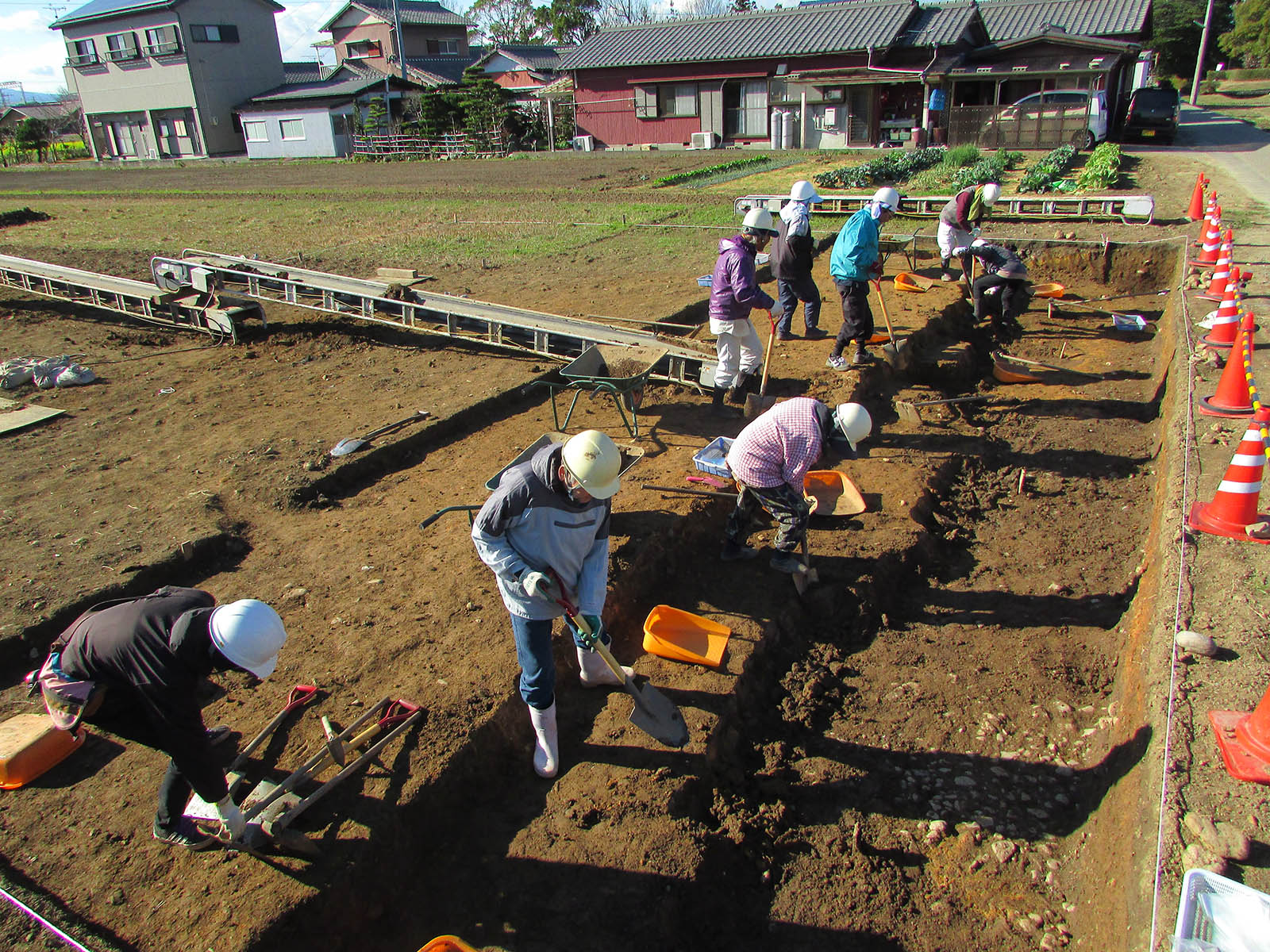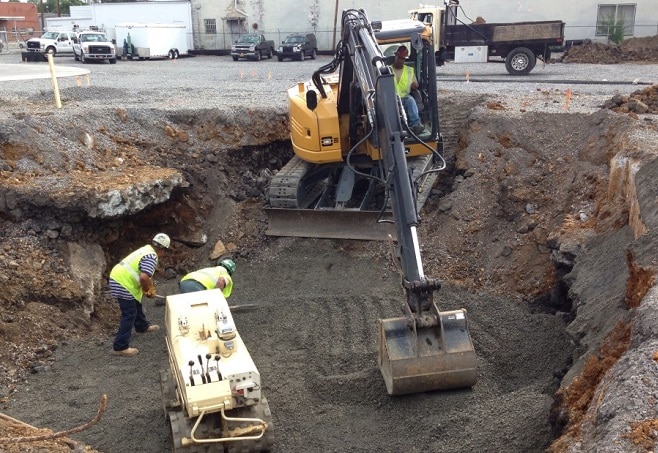General Contractor for Dummies
Wiki Article
Our Concrete Contractors PDFs
Table of ContentsGetting The Excavator To WorkThe Best Strategy To Use For Mini ExcavatorFacts About Grading Contractors UncoveredGeneral Contractor - QuestionsNot known Facts About Demolition


Scrapers or Pans dig deep into dirt in one location, haul and also discard the soil in another area (mini excavator). It is difficult to match the efficiency of scrapers for cut/fill soil procedure if the haul distance is less after that a mile. Scrapes are normally drawn by a rubber tire wheel tractor as well as are often pressed with the cut area by an excavator.
There are often times that scrapers are not used for website grading as well as a dump vehicle is employed: the haul may be to long, the haul may go across roads where scrapers are not permitted, tough rock may be run into, tools schedule, etc. Discard trucks are in usual use and also most likely require little discussion.
"Rock body" beds, on the various other hand, have no tailgates and also can discard any type of dimension rock, although their volume ability is reduced. Compaction Equipment increases the density of the soil and also in some situations gives a smooth, rolled surface area.
General Contractor - Truths
From a simple test pit to percussion boring to core exploration the owner has increasingly a lot more expensive options that produce progressively better information about the website underground. The Proprietor on a 100,000 SF structure project might license twenty uninteresting places with split spoon dirt examples taken till rock is gotten to and after that core examples of rock.Understanding the kind as well as high quality of rock (from the core samples) and location of rock (from the dirts boring) is a genuine benefit in jobsite planning. On the other hand, the Proprietor of a 100,000 SF building may determine to continue with no geotechnical testing whatsoever. The choice concerning geotechnical testing is usually made by an Owner without any input from the Building and construction Supervisor.
The area on Dirts as well as Geology assists you understand the terms in the geotechnical report. An understanding of the approximate place of the rock aids the Building and construction Supervisor to intend the sequence of actions complying with rock excavation. If rock is in one edge of a large building job, as an example, the planet excavation can start at the contrary end of the building in order to begin foundation work soonest.
Beginning the foundation job early would be a good concept if the rock can be gotten rid of by tearing. If the rock is exceptionally tough as well as requires considerable blasting, it might be sensible to hold foundation job up blog until the blasting is finished. The Building and construction Supervisor need to coordinate these sorts of choices as well as utilize all the technological day readily available.
General Contractor Can Be Fun For Anyone
Unidentified excavation states that all rock or various other unanticipated products (omitting hazardous products) run into in the sitework will be the obligation of the Specialist at no change in agreement cost. An unclassified excavation is easier from a book-keeping point ofview and also places the obligation for geotechnical problems onto the Sitework Professional.Exactly How Water Impacts Sitework? It's remarkable what a heavy rain can do to a building project. Prior to the rain, the website might be completely dry, heavy equipment successfully moving planet, the various other professions smoothly doing their work. Within hrs the task can be a careless, mud-hole with employee efficiency cut to concerning 10%.
In the majority of areas of the world, the Building and construction Supervisor have to remember a simple fact: IT WILL RAIN. Good planning can reduce the damage and disruption More Bonuses of a heavy rain to a jobsite. Frequently the excavation and also grading is entrusted to the Sitework Specialist (as well as their Foremen is accountable to monitor and direct the hefty tools and also drivers).
The Building and construction Manager should be constantly conscious of what rainfall will certainly do to the job site. It is not uncommon for the Sitework Supervisor to function their heavy devices for maximum efficiency and also wish it doesn't rainfall. One of the best means to plan for rain is to incline all qualities to drain and also to smooth rolled the surface area prior to a rainfall.
Concrete Contractors Fundamentals Explained
The Building and construction Manager must be perceptive sufficient to guarantee that heavy rain does not quit working on the project longer than required. Daily discussions with Sitework Foremen might be called for to attain this objective. Any type of time excavation is needed below the existing water level on a job, the process of dewatering must be considered.In a truly natural dirt, the water travels so slowly through the clay or silt that dewatering is not usually essential for the reasonably brief time of excavation. Dewatering may be required for a solitary ground excavation or for an entire task website. The most common dewatering approaches pop over to this web-site are trench drains, deep wells as well as well points.

Ground water seepage can also be lowered by cutoff techniques such as sheet piling. The prices for dewatering can be incredible, including tools leasing, labor and also electrical energy (or fuel). High dewatering prices have paled the earnings margins on far way too many jobs. The several variables listed here make the job of approximating dewatering costs really challenging, and also very inexact.
This choice should always be taken into consideration when evaluating the possibility of dewatering. Obviously the alternative is just viable if gravity can run the water to lower ground. Trench drains pipes can be reduced with a backhoe and loaded with a coarse, granular material (# 4 rock for instance), but treatment has to be exercised in selecting the water electrical outlet type as well as area.
Trencher - Questions
A siphon, necessarily, utilizes climatic stress to carry water from one altitude, up over a challenge, to a lower altitude. The pipes in a siphon system have to be airtight and also some ingenuity is often needed to completely fill up the siphon pipe. The siphon pipeline need to be full for the siphon to begin.A deep well consists of a pump, tube and an upright well casing. The pump intake is at the base of the well casing (normally some smashed stone is put there as a filter medium) (demolition). The water is inflated the hose pipe, out of the well case, and to an appropriate discharge area.
In a coarse sand, for instance, a huge location can be pumped to near the pump intake elevation. A much less absorptive dirt, on the other hand, minimizes the performance of a deep well. Considering that the pump is usually at the bottom of the deep well, there are no height restrictions as a result of vacuum lift, and deep wells can lower the groundwater over 50 feet.
Under of the wellpoint there is a 2 foot long display and also shutoff, water jets out of this shutoff and also creates an opening right into which the wellpoint pipeline can be reduced. This opening is often made a larger diameter (for instance 10 inches) to permit for a rugged sand backfill to aid filter the water (grading contractors).
Report this wiki page